skip to main |
skip to sidebar
 Ever heard of this cake? No? Really? All you fantastic cooks out there, you’ve never made this cake? Not even heard of it? Really? How very strange…
Ever heard of this cake? No? Really? All you fantastic cooks out there, you’ve never made this cake? Not even heard of it? Really? How very strange…
Ok, not so strange. Because I made it up The cake is just a pound cake with the ingredients halved because I could not bring myself to use four eggs in one cake. Plus the cake would have been wayyyy too large, even with the kids at home. So, I reduced all the ingredients by half – basically making a half-pound cake.
Then where did the “10 shilling” tag come from, you ask? Aha. Therein lies a very sad little play on words – mmmm... shall we say that I coined it? Ahahahaha!
Ok, here it comes. I’m guessing most of you know that before British pound went decimal in 1971, it was divided into twenty shillings and each shilling was divided into twelve pennies or pence. Although those divisions may seem odd, in fact having a pound divided into 240 equal parts does mean it can be exactly divided into halves, thirds, quarters, fifths, sixths, eighths, tenths, twelfths, fifteenths, sixteenths, twentieths, twenty-fourths, thirtieths, fortieths, forty-eightieths, sixtieths, eightieths, and one-hundred-and-twentieths. A decimal system allows precise division only into halves, quarters, fifths, tenths, twentieths, twenty-fifths, and fiftieths.
(If you math buffs want more of this sort of drivel, you can find the rest of it here.)
Guesses about the origin of the coined title, anybody? No? (I'm assuming no. I Want To Explain. I Have To Explain. How Else Could Anybody Appreciate This Exquisite Sense of Humour and Play on Words?) Ok, here's the explanation. A pound is 20 shillings, or used to be. Half of a pound is 10 shillings. Half of a pound cake, therefore, becomes...? Yes! A 10-shilling cake! Ta-DAAAA!
This 10-shilling cake was lucky to have come out as lovely as it did because in a fit of absentmindedness, instead of adding the butter to the bowl containing sugar (prior to beating the two till light and creamy), I plopped the butter into the bowl in which the egss were waiting to be beaten. Oooops!

Well, in for a penny, in for a pound (or a half-pound, or even 10 shillings! ahahahaha!), so I just tipped the sugar into the egg-butter mixture and beat the resulting mixture to within an inch of its life. It must have learnt its lesson, because the cake was light and crumby and delightfully lemony. Sometimes mistakes CAN be sammaLichufied (Tanglish - Tamil English - for "managed" or "made good").
Recipe for: Lemon 10-shilling cake

Ingredients:
1/2 cup butter, softened
1 cup sugar
2 eggs
1 tsp vanilla
1-1/2cups sifted flour
1/4 tsp. baking powder
1/4 tsp. baking soda
1/8 tsp. salt
1/2 cup buttermilk
Juice of one lemon
Icing:
1 cup icing sugar
Enough lemon juice to make thick or runny icing as per taste
Method:
1. Preheat oven to 170C. Spray a small (6") bundt pan with Pam, wipe off the excess, and set aside.
2. In large mixing bowl, beat butter with sugar and eggs vigorously, until the batter is light and frothy.

3. Sift together flour, baking powder, soda, and salt.
4. Add to butter mixture alternately with buttermilk and lemon juice, beginning and ending with flour.
5. Spoon batter into prepared pan and bake at 170C for 55-65 minutes until cake is lightly browned, set, and a toothpick inserted in the centre comes out clean.

6. Cool 5 minutes in pan, then invert onto serving plate and cool completely.
7. Mix icing sugar with lemon juice, then drizzle over the warm cake.

Let cool to set.
I made this cake for Christmas specially for my mother-in-law, as she couldnt eat the Christmas fruit cake because of her serious nut allergy. She has to be very careful what she eats - and by extension I have to be even more careful when she stays with us, making sure that everything I cook doesnt even have a hint of nuts. The recipe for this cake is from a book called "Cakes and Bakes" which I bought just before Christmas from a discount book store - man I LOVE those places! You can get such great bargains.
Anyway, the book has simple recipes with stunning photos... and this recipe caught my eye because it was different. It was called "Crunchy fruit cake", made with mixed exotic (read: dried pineapple, mango, etc) dried fruit and pine nuts. I fully intended to use the exotic mix because I had a bagful of it. (Had to leave out the pine nuts for obvious reasons.)
Just before I actually added the fruit to the cake mix, I glanced at the ingredient list and below that the allergy advice, not really expecting to see anything other than "dried mango, pineapple, papaya" and so on, and totally expecting it to only contain fruit. What else would you expect in a dried fruit mix, right?
I should have known better, though, because the pack said the contents were not suitable for nut allergy sufferers even though - get this - the recipe contained no nuts, the product was made in a nut-free area, but the contents could not be guaranteed nut-free as nuts might have been used elsewhere in the factory.
ARRRGH!
This is something that most food manufacturers seem to be stating nowadays as a way of covering their backside - just in case some nut allergy sufferer tries to sue them after a bad reaction to their product, I suppose. The thing is, no nut allergy sufferer can afford to take the risk of assuming that the manufacturers are only warning them off as a CYA (Cover Your Ass) procedure. So it makes it really difficult for people to buy ready-made food stuffs, even if it's only dried fruit for a cake!
I was really, really, REALLY glad that I happened to check the ingredients - perhaps there might not have been any nut traces in the dried fruit, but on the other hand, there might have been... and that could very well have been fatal for my mother-in-law. I have nightmares just thinking about what might have been, and I'm even more paranoid now about checking the labels on everything when she's with us, or if I make anything for her.
Anyway, because I couldnt use the exotic dried fruit, I checked to see if any of the regular sultanas or raisins could take their place. Nope. Same stupid warning on those packages as well. Luckily, there was a bag of dried currants which, amazingly, believe it or not, only contained dried currants! *gasp* Talk about Christmas miracles!

So that's why the fruit cake became a currant cake - and it was a lovely one. The amount of lemon juice used in the recipe gave a sharp flavour to the sweetness of the currants, adding zing to every bite. The currants sank to the bottom of the cake, but that didnt matter one whit, it made a lovely mouthful at the end! (It reminded me of a Famous Five adventure - cant remember which one - in which Dick says that he loves fruit cake where the fruit has all sunk to the bottom, making for a fruity last mouthful. For some reason that stuck in my head - sorry, I just HAD to mention it, irrelevant though it is!)
Pete's mother loved the cake, and so did I. So did Pete. Unfortunately for non-egg-eating folks, I'm afraid this required two eggs. The cake didnt rise much even with the two eggs and 1 tsp baking powder, so I doubt it would be possible to make it eggless. All I can say is, the cake was simple, and lovely! I'm almost tempted to give up Christmas fruitcakes, and I probably would too, but for Pete's howl of distress at the very thought. Did I mention he just lurrves fruitcake?
Recipe for: Polenta currant cake
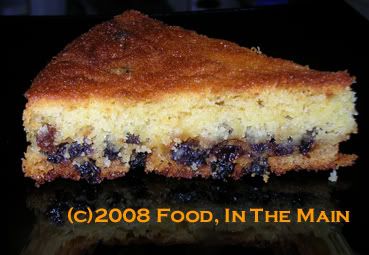
Ingredients:
5 tbsp butter
1/3 cup + 1 tbsp caster sugar
2 eggs, beaten
4 tbsp self-raising flour
1/2 cup polenta or cornmeal
1 tsp baking powder
1 cup currants
grated rind of one lemon
4 tbsp lemon juice
2 tbsp milk
Method:
1. Preheat oven to 180C/350F. Grease a 7" round cake tin with Pam (or use butter) and line the base with baking parchment.
2. Put the butter and sugar in a bowl and whisk together till light and fluffy.
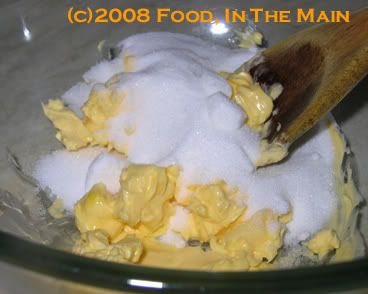
3. Then whisk in the beaten eggs, a little at a time, whisking thoroughly after each addition.
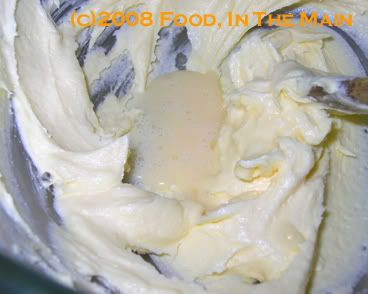
3. Gently fold the flour, baking powder and polenta into the mixture until thoroughly blended.
4. Stir in the currants, grated lemon rind, lemon juice and milk.
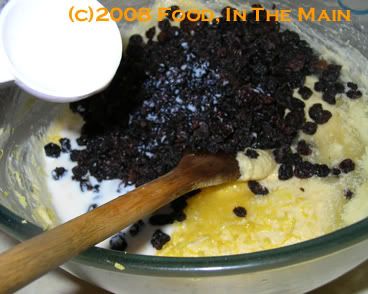
5. Spoon the mixture into the cake tin and level the surface.
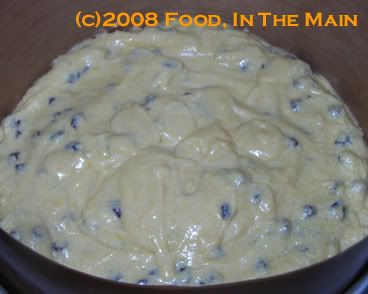
6. Bake in a preheated oven until the cake is golden on top, and a fine metal skewer inserted into the centre of the cake comes out clean.
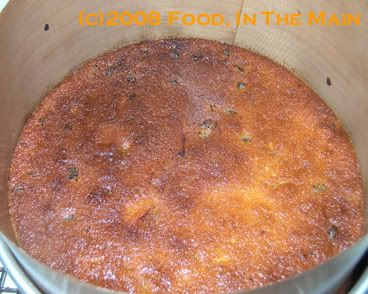
7. Leave the cake to cool in the tin before cutting.
There was quite a lot of the syrup left when I'd made stewed summer fruit, so Pete suggested I make a cake and use the juices to sweeten it. It seemed like a good idea, but then I wasnt sure how to set about it. Thank goodness for google, because I found a recipe here that was perfect for a starting point.
I didnt use half a cup of butter (as the recipe recommended) and I used wholewheat flour (actually it was chapati flour!) for the cake. Plus, of course, my cup-and-a-half of leftover fruit syrup. (Or you can use 1-1/2 cups of frozen orange juice concentrate in place of the syrup.)
Since I didnt add any extra sugar, I was pretty sure the cake would not have been quite sweet enough. Pete's suggestion was to make orange icing with fresh orange juice and orange zest, so I did - carefully this time, so that it didnt become runny. When he had a taste of the icing, he looked thoughtful for a few moments, then came up with yet another suggestion - to add grated ginger.
Now I like ginger in savoury dishes and use it all the time - but to use it, raw, in icing, didnt seem like the best idea. I was pretty sure it would be a horrible combination, but as it turned out, it worked remarkably well. So well that even I liked the icing despite my misgivings. So did Pete. He was actually quite magnanimous and didnt rub anything in - not the ginger, not the orange juice and not even his success! :)
I suppose that this is really Pete's cake - all I did was follow his suggestions. So here's his recipe for fruit juice cake with orange-ginger icing. Ta-dah!
Recipe for: Fruit juice cake with orange-ginger icing
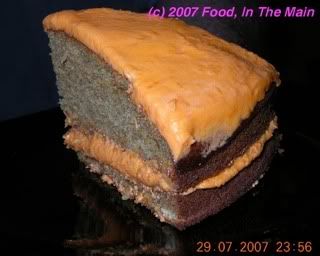
Ingredients:
2 tbsp butter, melted
1-1/2 cups stewed fruit syrup (or frozen orange juice concentrate)
2 eggs
1 teaspoon vanilla extract
2 cups whole wheat flour (or pastry flour)
1/4 tsp salt
1 tsp baking soda
For the icing:
2 cups superfine or icing sugar
1/2 tsp orange food colouring (optional)
1 tsp orange zest
A few tbsp fresh orange juice (as required)
1 tbsp fresh grated ginger
Method:
1. Combine the melted butter and the fruit syrup (or fruit juice concentrate) in a large bowl.
http://i6.photobucket.com/albums/y246/shyam69/More%20food%20blog%20pix/cake.jpg
2. Beat in the eggs until the mixture is smooth. Add the vanilla extract and beat briefly.
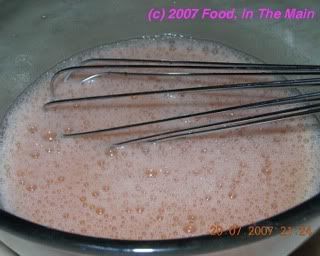
3. Measure the flour, salt and baking soda into the bowl.
4. Whisk the mixture until the batter is smooth and fluffy. This will only take a few moments.
5. Pour the batter into an 8" round baking pan sprayed with Pam.
6. Bake the cake at 350°F (180C) for 35 minutes or till the cake tests done. It should be golden brown and pull away from the sides of the pan.
7. Split the cake in half when cool, and ice with orange-ginger icing.
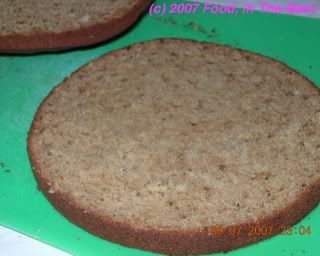
Store covered in the fridge.
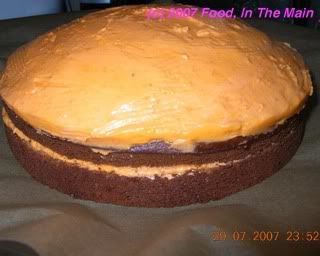
8. To make the icing, beat 1 cup icing sugar with 1-2 tbsp orange juice until fluffy. Alternate the remaining icing sugar with orange juice until the icing is creamy and thick enough to spread.
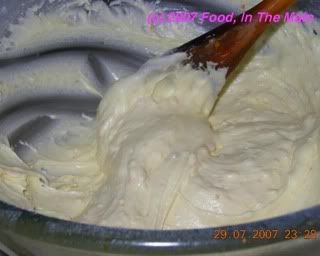
9. Add the orange zest, orange food colouring and grated ginger and beat well until fluffy and well incorporated.
I'm not sure I quite know what to say about this pudding cake... by anybody's reckoning it should have been a disaster, considering my mistakes - I cant blame the recipe, it was from "Gourmet July 2005", according to the printout. And yet it turned out to be a delicious cake.
In hindsight, I think the blueberries went in with too much liquid and the cake simply wouldnt set because the batter was so liquidy. The original recipe confidently said that the blueberries would sink to the bottom, so when I poured the blueberry mixture over the cake batter, I expected the blueberries to perform as per the recipe.
Although I waited expectantly, the blueberries didnt sink. They just pooled in the middle of the batter, creating a sunken effect, and didnt even bother to give an impression of being cooperative enough to do as the recipe indicated.
Right about then, while I gazed at my concave batter, I got that sinking feeling (I suppose I should have been glad that SOMEthing sank, even if it wasnt the darned blueberries) which precedes a culinary catastrophe. I did debate for a moment whether I should just throw it all in the bin and wash my hands of the whole thing - but I would have felt far too guilty throwing away perfectly fresh, lovely and expensive blueberries without even trying to salvage them!
Good thing, too. Like I said, the cake should have been a disaster but somehow it worked. I had to bake it for far, far longer than the recipe said, because the bloomin' blueberries simply wouldnt set in the centre! Not that I blame the blueberries... there was far too much liquid, so it took an extra long time. By which time, of course, the cake part was well cooked and somewhat crusty around the edges, although not burnt. I finally switched off the oven when the blueberries had a sort of jelly like texture in the centre - still not "set" but I hoped that (like with baked cheesecakes) the centre would firm up as it cooled.

It did set, but it was like a chewy jam/jelly in the middle with lots of fruit in every bite! Doesnt sound particularly appetising (nor does it look it in the photo above), but no amount of descriptions can do justification to the taste, which was just lovely - perhaps the extra long time in the oven concentrated the flavours of the blueberries, I dunno. But in any case, it disappeared like magic (it helps that there are two hungry teenagers here right now, but still), helped along by some thick fresh cream.
Next time I make this, I'll make sure that the blueberries are not poached in too much water - that, I think, was the main problem with what I did. The recipe below rectifies the things I think I did wrong. So, hopefully anybody who tries this recipe will have a more conventional looking cake that also tastes lovely!
Recipe for: Blueberry pudding cake

Ingredients:
1/3 cup sugar
PLUS
1/2 cup sugar
1/4 cup water
1 tbsp fresh lemon juice
1 tsp cornflour
1-1/2 cups blueberries
1 cup all-purpose flour
1-3/4 tsp baking powder
1 tsp salt
1 large egg
1/2 cup milk
3 tbsp unsalted butter - melted and cooled slightly
1 tsp vanilla
Method:
1. Preheat oven to 180C. Spray an 8" round pan with Pam.
2. Stir together 1/3 cup sugar with water, lemon juice, and cornstarch in a
small saucepan, then stir in blueberries.

Bring to a simmer and let it cook 3 minutes, stirring occasionally. Remove from heat.

3. Whisk together flour, baking powder, salt, and remaining 1/2 cup sugar in a
medium bowl.
4. Whisk together egg, milk, butter, and vanilla in a large bowl.

Then add flour mixture, whisking until just combined.
5. Put batter in the baking pan.

Then pour blueberry mixture evenly over the batter (berries will sink - hopefully!).

6. Bake until a knife inserted into centre of cake portion (towards the side, not the centre of the cake) comes out clean, 35-40 minutes.
7. Cool in pan on a rack for five minutes, then remove to a serving plate.

Serve warm with fresh strawberries and cream or icecream.

Description:
"Plump blueberries, cooked until juicy and poured over a simple batter,
create a deliciously moist pudding cake bursting with summer fruit."
Source: "Gourmet July 2005"
Yesterday evening I was sorting out some of the hundreds of pages of dessert and baking recipes that I've printed out over the years - and yeah, only a fraction of them have been tried and posted. The others were printed out at various moments when I was feeling energetic and optimistic (not to mention, overenthusiastic) about trying complicated gateaux or gourmet dessert recipes...
But in the end, all I've ever done is read through them with just two thoughts running through my head over and over during the reading process.
The first thought: "Wow, that sounds so fantastic, too bad it's so complicated". And the next one: "Too bad I dont know anybody who would make it..." - and most important, this - "...and call me over to taste it!... followed by the first thought, followed yet again by the second thought (ofc with the all-important second part of the second thought)... and so on. You get the idea. I could probably go on like this all evening, so the expedient thing would be to agree that yes, you get the idea. :)
Anyway, I came across this recipe that had the intriguing title of "Amazon cake". Amazon cake? I thought. Why Amazon cake? So I quickly read through the recipe, which was ridiculously simple and, better yet, didnt require eggs. Ah-HA. The printout said that the recipe was from The New York Times, adapted from Cafe Beaujolais by Margaret Fox and John S Bear. That's all I know about it. (It never got around to explaining why Amazon, so I remain intrigued. And ignorant.)
So of course, since chocolate cake is the all-time favourite of my family, I made it. Easy as easy as can be and the cake was quite lovely. You wouldnt have known that it didnt contain eggs. I cut down on the sugar in the cake from 1 cup to slightly less than 3/4 cup, but that's because I was planning to frost it. If you dont want to frost it, use 1 heaping cup sugar for the cake.
The crumb was moist but not dense, and the end product disappeared like magic.
The Amazin' Amazon cake is here to stay!
Recipe for: Amazin' Amazon eggless chocolate cake
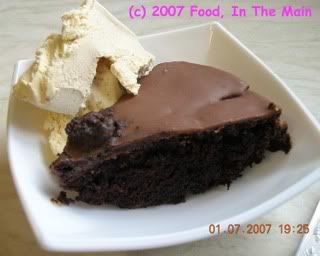
1-1/2 cups flour
1/3 cup unsweetened cocoa powder
1 tsp baking soda
3/4 cup sugar
1/2 tsp salt
5 tbsp oil (corn oil, canola, vegetable or sunflower oil)
1-1/2 tsp vanilla extract
1 tbsp cider vinegar
1 cup cold water
Method:
1. Heat the oven to 350F (180C). Grease a round 9" baking pan.
2. Whisk together the flour, cocoa, baking soda, sugar and salt in a medium bowl.
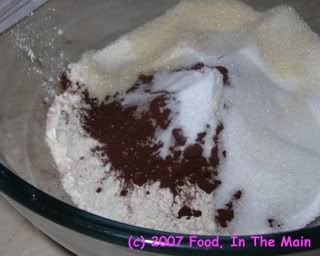
3. In a separate bowl, whisk together the oil, vanilla and vinegar with 1 cup cold water.
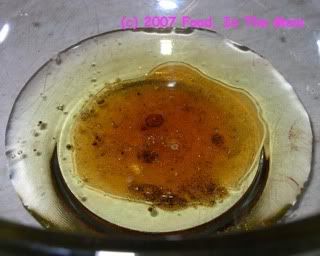
4. Then add the dry ingredients (flour mix) and whisk it all together, until the batter is lump free.
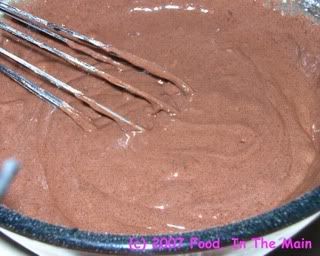
5. Pour into the prepared pan and bake for 40-45 minutes or till the cake tests done.
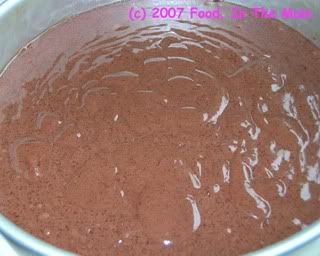
6. Cool before removing from the pan. Frost the cake when it is completely cool (any frosting is fine), or just sift icing sugar over the top before serving.
Another of those long goods-train-like, really catchy names that I'm so good at manufacturing. But this time, consider ooey-gooey to be the adjective that qualifies the noun (hey, I did English Literature in college, can you tell?). The noun here being the actual title for this post (and the cake) - which is, of course, pineapple pudding cake. Not too bad, that. Straightforward and factual. With a bit of English grammar thrown in gratis.
Considering that I hadn't really had much faith in the outcome of the recipe (I'm a major Doubting Thomas, me!), I was rather pleased with the result. I got the recipe off a lycos food group that I subscribe to - that is to say, I subscribed looooong back and didnt get around to unsubscribing. Partly because I couldnt be bothered, and partly because once in a while, I manage to salvage a little drop from the massive waves of recipes that crash into my inbox every day.
Are you wondering if this pineapple pudding cake is one of those salvaged drops? Yes, sort of. Sometimes those drops of water turn out to be little sparkly gems, and sometimes they're just - well, a recipe that manages to work. This is one of the latter kind... not quite a gem, but not dross either. That's my opinion. My mother and Pete - especially Pete - thought it was incredibly good.
I had serious doubts about the glaze (for want of a better name) for the cake. The cake itself wasnt bad, for an eggless one, using the one-bowl method. But the recipe said the glaze had to be poured boiling hot over the hot cake. I had mental visions of the cake promptly disintegrating into a soggy mess, so I hesitated an awful lot before going ahead. My mother didnt help by peering at the contents of the saucepan - which was bubbling merrily, a mixture of evaporated milk, a bit of condensed milk, margarine, sugar and chopped nuts - and saying in an extremely doubtful tone: "Are you going to pour THAT over the cake?"
I suppose that did it. I consider myself at perfect liberty to second-guess instructions in other people's recipes and query methods given in cookery books - but to be second-guessed about something I'm making (even if from some unknown recipe) is not on.
So before anyone else could convey their doubtful disbelief, I promptly poured the hot glaze over the hot cake - but then I was too chicken to follow through on the consequences. Basically, after pouring the glaze, I turned my back on the cake, switched off the kitchen light and went off to watch a movie.
Did I think about the cake? Nope. Not at all.
A few hours later, I went to check on the cake somewhat fearfully, expecting to see a disintegrated mess on the plate - but to my surprise, the cake was still standing. All the excess glaze that had overflowed on the plate had been soaked up by the cake itself.
Thrilled to see the whole thing still in one piece, I let Pete cut himself a slice. It was ooey and gooey and more pudding than cake - he had it with honey vanilla icecream and pronounced the combination delectable. When I tried it, I found it rather too sweet for my liking - but my sweet tooth is very quickly satisfied, so I'm not the best judge.
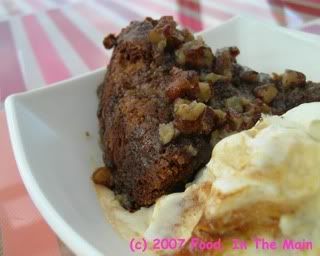
The final verdict is: If you like gooey moist sweet cakes, this is the one for you. The glaze sort of caramelized (if that's the right term) to a darkly sweet texture - you could certainly say that the sum of the parts added to more than the whole! Or something like that, anyway.
Recipe for: Pineapple pudding cake
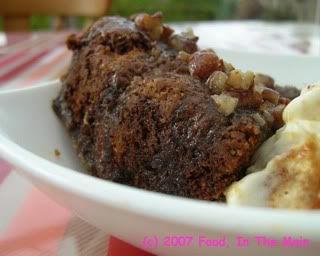
Ingredients:
For the cake:
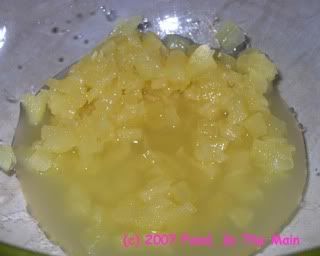
1 cup crushed pineapple with juice (NOT syrup)
1/2 cup white sugar
1-1/2 cups plain flour
3 tsp baking soda
2 tbsp milk
1/2 tsp baking powder
1/4 tsp salt
1/4 cup vegetable oil
2 tbsp demerara sugar (or use brown sugar)
For glaze or topping:
1/2 cup evaporated milk
3 tbsp condensed milk
1/4 cup butter or margarine
1/2 cup white sugar
1 tsp. vanilla
1/4 cup chopped pecans
Method:
1. In a large bowl, mix all the cake ingredients together (except the demerara/brown sugar) until the flour is incorporated. The batter will be quite thick.
2. Scrape batter into a greased 6" round cake pan. Even it out with the back of a wetted spoon.
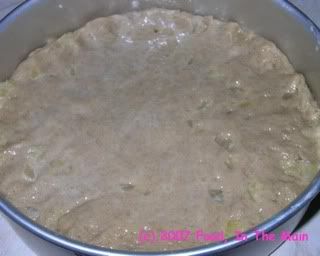
3. Then sprinkle the demerara or brown sugar over the top.
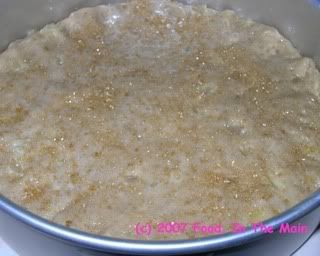
4. Bake at 180C (350F) for about 45 mnutes or till the cake tests done and has pulled away slightly from the sides.
5. When the cake has been in the oven for about 35 minutes, make the glaze/topping. Put all the topping/glaze ingredients in a small pan.
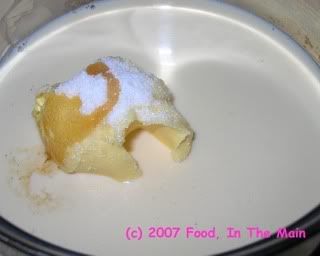
6. Bring to a boil on medium heat, stirring till the butter/margarine has melted completely, and let it bubble gently for a couple of minutes.
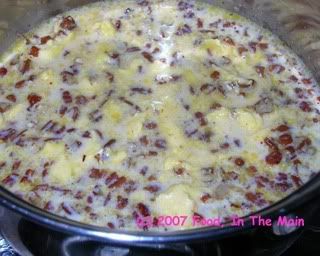
7. When the cake is done, turn it out onto a serving plate.
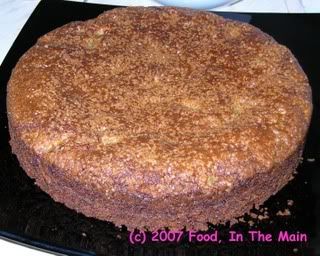
8. While it is still hot, pour the hot topping on the cake.
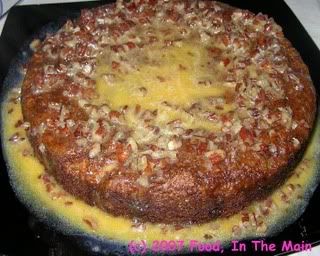
9. Let it cool completely (preferably leave it overnight) before cutting. Serve with vanilla icecream.
Yeah, I suppose I could have used my loaf to come up with a catchier title for this really rather yummy cake-bread. ("Used my loaf" - get it? This is where y'all chuckle, smile, roll your eyes, make a face, groan, whatever. Any of those or all of them, in any order preferred. Just acknowledge the stomach-churning brilliance of the pun!)
But I didnt come up with a snappier title, and neither loaf helped the process in the least - one sat there looking inscrutable (YOU try anthropomorphising or analysing baked goods!) and the other sat there lacking brain cells. End result: to describe this cake to anyone, you'll need a very deep breath to recite "Lemony tea loaf with dry fruits, berries and sliced almonds?" all at one go.
Right. Now that's clear.
This is an eggfree recipe from - yes, you guessed it! - Cintia Stammers' book . I'm afraid I took the basic recipe and ran with it somewhat, because after the last eggfree baking disaster, I wasnt about to keep the recipe as simple as the book would have it.
So I added some vanilla extract and a large handful of mixed dry fruits, berries and sliced almonds - and, because I had a little bit of Sprite (I was drinking it because the evening was so VERY hot) left over in the can, and because it would have overfilled my glass, I added that as well to the batter, as an afterthought. No point wasting stuff, is there?
In retrospect, perhaps I should not have added the 3 tbsp-odd of Sprite. Not in addition to the baking powder and soda, anyway.
Bet you thought this was the prelude to yet another but entertainingly different baking experience from which I come out with egg all over my face. Right? Hah. You were wrong! WRONG! The yolk, my friends, is on you! This time, I couldnt have come out with egg on my face because - wait for it - I didnt use eggs in this recipe. Devilishly devious, that's me.
So, anybody still hanging around in the hope of reading about the loaf-cake? Your patience is going to be rewarded now.
The reason I've come to the conclusion that adding the Sprite was not the best idea is because the loaf crust came over all crisp and crumbly. Like bread. Which is good for bread, but I was going for a more cakey texture in loaf shape. My mother suggested that perhaps there was too much soda - hence I decided that the Sprite was the culprite. I mean culprit.
The cake tasted very nice and sweetly lemony, with the occasional bite of sliced almond and chewy dried fruits. The only way it failed my expectation was, as mentioned, in the crust area, which made it difficut to make neat slices.
Oh, the batter made one 750gm loaf and three bitty little loaves, which I didnt weigh.

But if you want to make this loaf-cake and you possess a 2-pound loaf pan, that's what you should use. The recipe said so.
Recipe for: Lemony tea loaf with dry fruits, berries and sliced almonds

Ingredients:
1-3/4 cup all-purpose flour
4 tbsp butter or margarine
3/4 to 1 cup caster sugar (depending on your sweet tolerance - I used 3/4)
2 tsp vanilla extract
1/2 cup mixed dry fruits and sliced or chopped nuts
3/4 cup milk
Juice of 1-1/2 lemons
1-1/2 tbsp finely grated lemon zest
1/2 tsp soda bicarb
1 htsp baking powder
Method:
1. First, put the milk in a small bowl, add the lemon juice and let the milk curdle.

Preheat the oven to 180C and lightly grease a 2-pound loaf pan.
2. In a medium bowl, beat the butter and sugar till it is fluffy and light. Add the lemon zest and mix in

then add the dry fruits and nuts.

3. In another bowl, sift together the flour, soda bicarb and baking soda.
4. Add the curdled milk and the sifted flour by turns to the butter mixture, beating well between additions. Continue till the milk and flour are used up. The batter will be quite thick.
5. Mix in the vanilla extract and transfer the batter to the prepared loaf pan.
6. Bake the loaf for about 45 minutes or till a tester inserted in the centre comes out clean.
7. Remove the loaf pan from the oven but let the cake remain in the pan for 10 minutes. Then gently remove it from the pan and let cool completely on a wire rack.

Tip: Drizzle or pour lemon icing thinly over the top of the loaf for an even lemonier flavour. (I wish I'd remembered to do this before I cut the cake-loaf!)
I do believe I'm beginning to get rather fond of my eggless baking book! Another ridiculously easy cake that tastes wonderful - can you believe there's no beating or creaming or any such hard work involved? It's a one-step cake. Basically, get all the ingredients together, mix 'em and shove into the oven for about 40 minutes.
As is usually the case, I did make a few changes to the original recipe to make the cake more "Indian" tasting - with an added tip remembered from a Madhur Jaffrey cookbook. Basically, to substitute some of the butter with 2 tbsp ghee for that carrot halwa taste without having to suffer the smell of cooking carrots.
For certain my mother's enjoying my baking efforts. For all that she moans that she'll put on all the weight she lost in India (by being unwell), it doesnt stop her from "sampling" my eggless cakes. I'm going to try and make as many from the book as possible while she's here... and eventually see if I cant adapt other cake recipes to be egg-free. It's going to be a slow journey but who cares!
The next thing I'd like to try is a pressure cooker cake, suggested by Vijayalaxmi Hegde in a comment on my previous post. I know there are some Chinese-style pressure cooker cake recipes around, but those arent what I want to try just yet.
Anyway, for now here's how to make my spicy eggless carrot cake.
Recipe for: Carrot cake

Ingredients:
1 heaped cup AP flour
1 tsp baking powder
1 tsp baking soda
4 tbsp soft butter (I used 2 tbsp ghee and 2 tbsp butter)
1-1/2 cups grated carrots
1/2 cup caster sugar
3/4 cup yogurt
1/4 cup chopped nuts - I used pistachios and pecans
1/4 cup sultanas
1 tsp fresh grated ginger
1/4 tsp nutmeg
a large pinch of cardamom powder
Method:
1. Grease a 6" square pan. Preheat the oven to 180C(350F).
2. Sift together the flour, baking powder and baking soda in a big bowl.
3. Add the ghee/butter
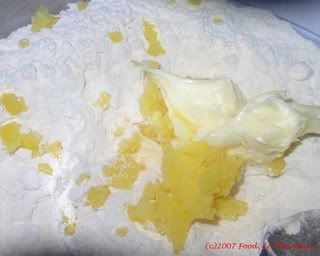
yogurt
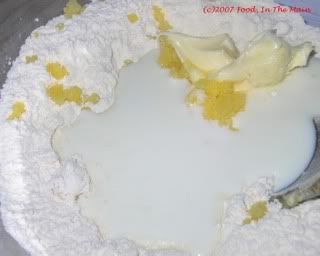
and sugar
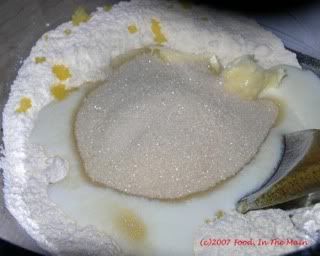
and mix. The batter will be quite thick at this point.

4. Add the grated carrots, ginger, spices, nuts and sultanas.
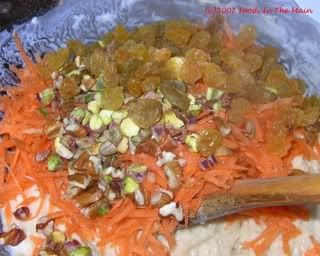
5. Mix well. The moisture from the carrots should make the batter a little loose, but if it seems still too thick, add a little more yogurt and mix again.
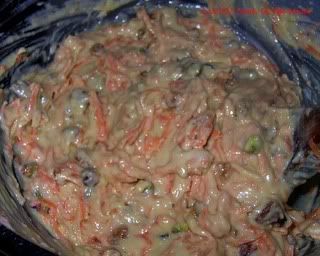
6. Scrape the batter into the prepared pan and smooth the top with a wet spatula or with your hand.
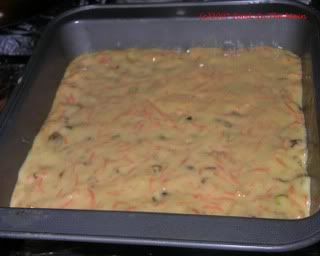
7. Bake at 180C for 40 minutes or till the cake tests done. Let the cake remain in the pan for 10 minutes.
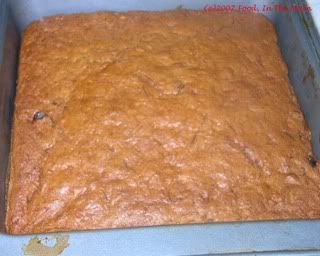
8. Loosen the cake from the sides of the pan, if required, and turn out onto a wire rack to cool.
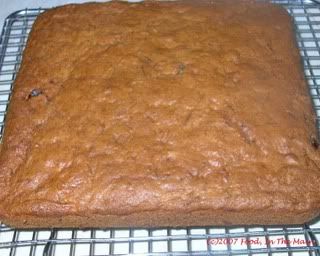
9. Cut into squares or rectangles when cool. Store in an airtight tin.


























































